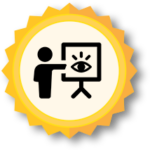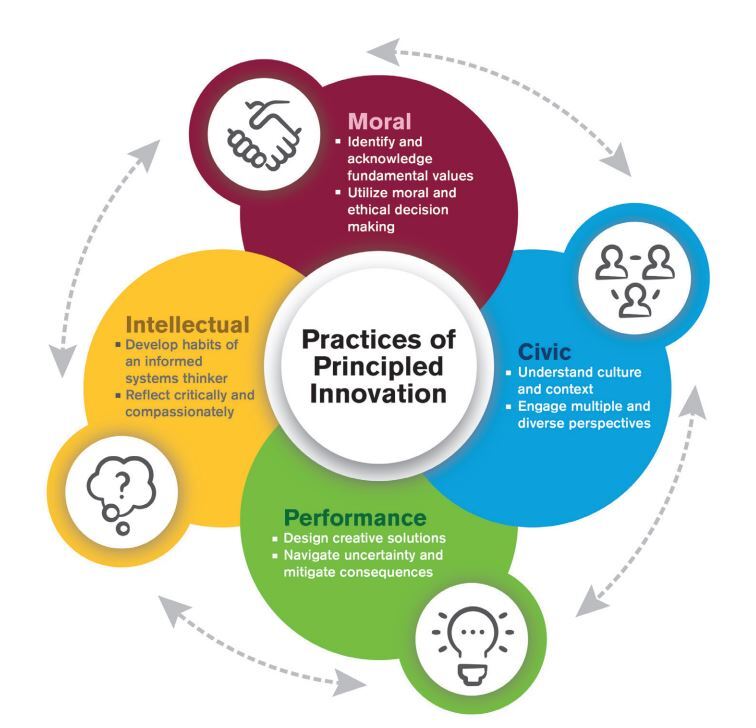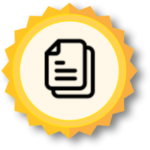Engineering Ethics and Principled Innovation

Overview and Introduction: The WHAT and WHO
Overview and Introduction: The WHAT and WHO
Engineering ethics is a field of study that examines the ethical implications of engineering practice. It is concerned with the moral obligations of engineers to society, to their clients, and the profession. The primary goal of engineering ethics is to promote integrity, professionalism, and accountability within the engineering field. It provides a framework for engineers to navigate complex ethical dilemmas, balancing competing interests and making decisions that prioritize safety, sustainability, and the greater good.
Engineering ethics is closely connected to Principled Innovation, which is one of the new design aspirations in ASU’s charter. Principled Innovation (PI) is the ability to imagine new concepts, catalyze ideas, and form new solutions guided by principles that create positive change for humanity [1]. PI is based on the belief that character and values are essential for innovation. When people are guided by strong character and values, they are more likely to make ethical decisions, take risks, and persevere in the face of challenges. This, in turn, leads to more innovative and impactful solutions to problems. The four pillars of PI are moral, civic, intellectual, and performance.

All engineering students in FSE are required to take an ethics-related course within their discipline for ABET accreditation (e.g., CSE 301: Computing Ethics, MAE 400: Engineering Profession). However, all students across modalities and types of courses can benefit from learning about engineering ethics and principled innovation across the engineering curriculum. This QRG considers several ways that any engineering faculty can implement engineering ethics into their courses.

Implementation and Timing: The WHEN, WHERE, and HOW
Engineering ethics is typically taught using case studies, discussions, and codes of ethics. In some cases, an introduction to moral theory is also provided to give a solid foundation for ethical decision-making, especially within ethics courses [2]. Engineering ethics education covers two main areas: microethics and macroethics [3].
- Microethics: Microethics focuses on the individual professional responsibilities of engineers. This includes topics such as honesty, integrity, and competence. Engineers have a responsibility to use their skills and knowledge to the best of their ability and to act in a way that is honest and ethical. They also have a responsibility to protect the public from harm and to uphold the highest standards of professional conduct.
- Macroethics: Macroethics deals with the development of technology and its impact on society. This includes topics such as environmental impact, social justice, and intellectual property. Engineers have a responsibility to consider the ethical implications of their work and to use their skills to create technology that benefits society. They also have a responsibility to protect the environment and to respect the intellectual property of others.
Engineering ethics should be implemented throughout engineering education. It should be introduced early in the curriculum so that students can begin to develop an understanding of the ethical principles that guide engineering practice. It should also be revisited throughout their education, as students learn more about the technical aspects of engineering. Faculty who teach second and third-year courses should consider how to build on the ethical considerations from Introduction to Engineering courses. Consider the ideas for implementation below, including discussions, written reflections, and guest speakers. This continued and frequent ethical consideration across many classes will help students to apply the ethical principles they learn to real-world situations and bridge the topic of engineering ethics to their upperclassman ethics course or capstone projects.
Ideas for Implementation
- Case studies and discussions. Case studies can help students to understand the ethical dilemmas that engineers face in their professional lives. By discussing case studies, students can learn how to think through ethical issues and make ethical decisions. Case-based learning is taught through modeling of cases and facilitating student-centered learning by working through potential solutions [4]. Create small group discussions or discussion board prompts.
- Invite guest speakers. Provide students with opportunities to discuss ethics with engineers in the workforce. Invite guest speakers from industry, professional organizations, or regulatory bodies to share their experiences and insights on engineering ethics. By inviting these experts into the classroom, students can gain a better understanding of how ethics is applied in the real world. Contact the FSE Career Center for industry contact recommendations.
- Written reflections. Writing papers, lab reports, or project deliverables with ethical reflection opportunities can help students to develop their ethical thinking and to articulate their ethical positions. A few examples and resources are below:
- Professional Responsibility: Reflect on your role as an engineer and the ethical responsibilities you have towards clients, colleagues, and the public. Consider real-world examples where professional responsibility has been tested and discuss the impact of ethical choices on the engineering profession and society.
- Code of Ethics: Select a specific engineering code of ethics (e.g., ABET, IEEE, ASME) and reflect on its principles and guidelines. Discuss the relevance and significance of the code in guiding ethical behavior in engineering. National Science Teaching Association Case Studies.
- Emerging Technology: Choose an emerging technology (such as artificial intelligence, genetic engineering, or autonomous vehicles) and reflect on its ethical implications. Consider the potential benefits and risks, as well as the social, environmental, and human impact. Discuss how engineers can navigate ethical considerations in the development and deployment of such technologies. Kern Entrepreneurial Engineering Network (KEEN) Case Studies.
- Decision-Making through Principled Innovation: This guide includes several reflection prompts centered on the four pillars (i.e., moral, civic, intellectual, and performance).
- Stay up-to-date on the latest developments in engineering ethics. This will help faculty teach ethics in a way that is relevant to the current challenges facing engineers. A few centers and resources below:
- National Academy of Engineering’s Center for Engineering Ethics and Society
- IEEE’s Engineering in Society Program
- American Society of Mechanical Engineers’ Engineering Ethics Division
- American Institute of Chemical Engineers’ Center for Process Safety
- Society of Automotive Engineers’ SAE International Council on Ethics and Responsibility

Rationale and Research: The WHY
The revision of accreditation criteria for engineering schools in the United States has enhanced the significance of teaching engineering ethics and the societal context of engineering [3]. Engineering faculty can educate students in engineering ethics across the curriculum, to ensure that students are introduced early on in their engineering education so that they can begin to develop an understanding of the ethical principles that guide engineering practice. Incoming generations of students are increasingly driven by social issues [5]. With the addition of Principled Innovation as one of ASU’s design aspirations, FSE faculty and staff need to understand how to support students’ decisions and actions to meet the social, cultural, emotional, and educational needs of those affected while creating positive change for humanity [1].
Faculty do not need to be an expert in ethics to lead a discussion on ethical issues. They can simply facilitate the discussion. What’s important is that you’re raising ethical issues in the classroom, as Pat Crosky details in his video, What kind of person do you want to be?

Additional Resources and References
Principled Innovation Resource Library: This includes a robust library of original and linked online materials, including videos, readings, and activities.
Entrepreneurial Mindset Ethics Applications: Below are several examples with resources of how engineering ethics and the entrepreneurial mindset.
Ethics and Professionalism Paper by Darryl Morrell (Dropbox): Students are required to create a reflective document about their understanding of ethical and professional responsibilities. This paper was created for mechanical/manufacturing engineering but can be applied across many engineering disciplines.
Ethics and individual project report by Ryan Meuth (Dropbox): In this report, students reflect on their project contributions and describe the value personally created for their customer, in economic, social, and/or environmental contexts. An ethics slide deck is also included.
Like these resources? See a full list of entrepreneurially minded content here, created by Robust Entrepreneurially Minded Leaders (REMLs) at ASU.
Kern Entrepreneurial Engineering Network (KEEN) Cards
- Teaching Entrepreneurial Mindset + Engineering Ethics for Sustainability by Samantha Brunhaver and AbdelRaouf Mayyas (ASU): Students apply Entrepreneurial Mindset (EM) and Engineering Ethics (EE) to a sustainable design project.
- Taking Action on Ethics by Heather Dillon (University of Washington Tacoma) and Jeffrey Welch (University of Portland): Students design an action plan to voice an ethics concern at work.
- Ethics, Climate Change, and Geoengineering by Jonathan Spelman (Ohio Northern University): This assignment sparks curiosity and prepares students to create extraordinary value by having them reflect on the ethics of geoengineering. Students are given a prompt, readings, and do a small group presentation to defend their answers to the ethical prompt.
Note: The majority of KEEN cards require the user to be logged in to view on the Engineering Unleashed platform. It is free to create an account – faculty can then connect with other ASU faculty or faculty across the network once signed up.
References
[1] Arizona State University. “Principled Innovation.” [Online]. Available: https://pi.education.asu.edu/. [Accessed: May 22, 2023].
[2] K. S. Bernhardt, M. Roth, D. Brandes, and A. Kney, “Engineering ethics: Teaching moral theories to engineers,” in 2002 Annual Conference, pp. 7-484, June 2002.
[3] J.R. Herkert, “Engineering ethics education in the USA: Content, pedagogy and curriculum,” European Journal of Engineering Education, vol. 25, no. 4, pp. 303-313, 2000.
[4] Lavi, R., & Marti, D. (2023). A Proposed Case-Based Learning Framework for Fostering Undergraduate Engineering Students’ Creative and Critical Thinking. Journal of Science Education and Technology, 1-14.
[5] Forbes, “For Millennials And Gen Zs, Social Issues Are Top Of Mind: Here’s How Organizations Can Drive Meaningful Change,” Forbes, July 22, 2021.